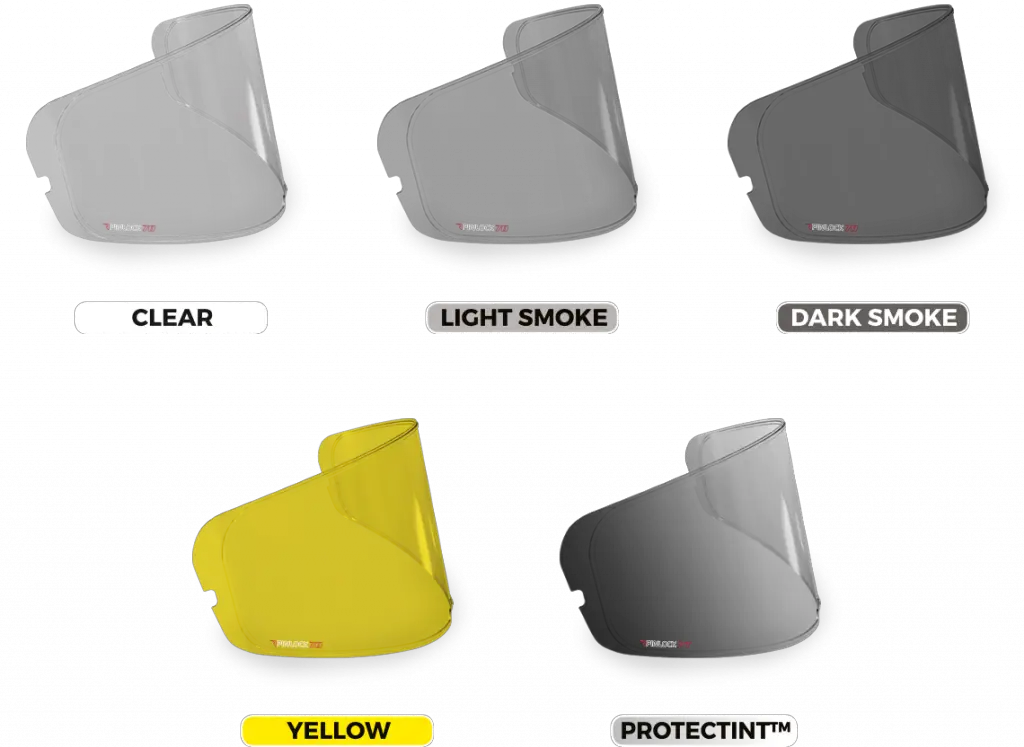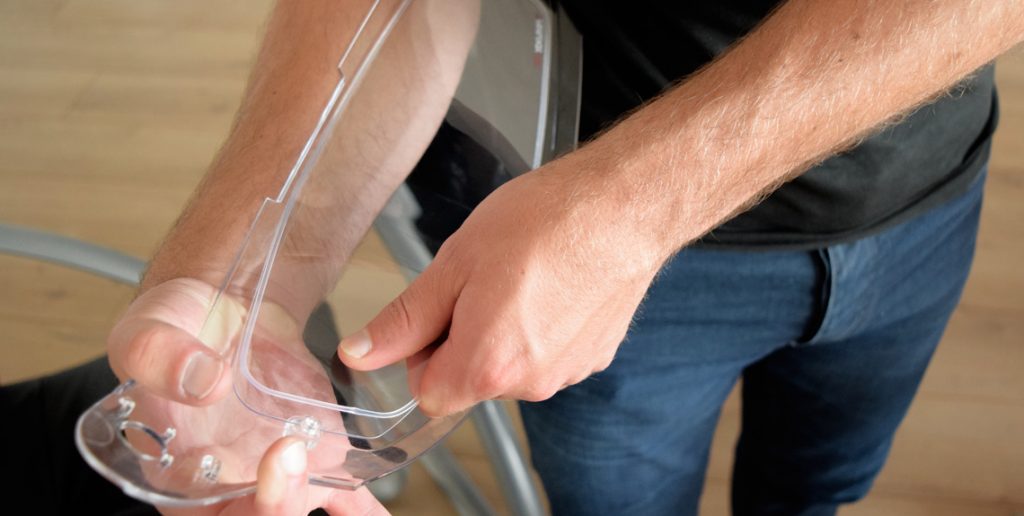There are few things more annoying when you are riding your motorcycle than your helmet visor fogging up and blocking your vision.
It is particularly annoying when you are riding in cold weather and the only way to clear your visor or to see the road is to open it up to have cold air blowing on your face.
However, all is not lost, there are several effective ways to keep your visor mist-free.
How Do You Stop Your Motorcycle Helmet Visor Fogging Up?
The most effective way to keep your helmet visor from fogging up is to get a Pinlock insert for your visor. Although there are some pretty good anti-fog sprays available and homemade options like washing up liquid that are also up to the task especially if you use a combination of options.
Here are the main ways riders keep their visors fog-free:
- Pinlock visor inserts
- Other anti-fog inserts – that use similar ‘Pinlock style’ system or stick on inserts
- Anti-fog spray
- Dishwashing liquid
- Open vents and visor when riding
- Anti-fog mask
- Water repellents
Let’s take a look at the options for keeping your visor clear in some more detail.
Pinlock Inserts
What Is A Pinlock Insert?
A Pinlock insert is a thin piece of moisture-absorbing plastic composite that sits between two ‘pins’ on the internal side of the helmet visor with the sole purpose of absorbing any condensation keeping the visor clear.

Pinlock’s were invented back in 1994, they took a while to be taken on by helmet manufacturers and motorcyclists but now they are very popular and many helmets come with a Pinlock insert or at least a Pinlock ready visor.
Pinlock inserts come in a range of tints; clear, light smoke, dark smoke and Protectint.

The Smoke and Yellow inserts work in the same way that tinted visors do, but the Protectint is one of the most interesting.
It is a sun reactive insert that stays clear until the sun is out and then darkens; it is a piece of clever technology that would mean you don’t have to carry an extra tinted visor allowing you to ride in all weathers and from daytime to nighttime seamlessly.
Pinlock’s come in a variety of sizes to suit different manufacturers visors sizes and shapes.
They are also rated in a number system by 30, 70 and 120. These three ratings indicate how effective the insert is:
- 30 – Casual use
- 70 – Regular use
- 120 – Intensive use
How Does A Pinlock Work?
A Pinlock insert sits on the internal side of a helmet visor trapped between two pins, it forms an air-tight seal which in turns acts as a kind of double-glazing, preventing condensation from forming.
No condensation means no fog forms and you have a clear visor.
The insert has a silicone beading around the edge that forms an air-tight barrier between the insert and visor, preventing condensation.
However, the insert actually also absorbs moisture so no condensation forms directly on that either.
The two pins can be turned to ensure a tight fit, the seal needs to be completely tight against the visor otherwise the system will fail and moisture will build up.
Pinlock’s are made to cover most of the usable area of the visor for maximum visibility, however where the pinlock does not cover, you should know that fog can still form.
MaxVision inserts are available to offer maximum coverage.
A very important note is that the visor needs to be Pinlock ready otherwise an insert cannot be fitted.
If buying a new helmet you will be able to see on the advertising that the visor helmet is Pinlock ready or check with the manufacturer to be 100% sure.
A quick way to check is to look for the two pins either side of the visor that the insert fits between.
See the photo below for what to look for.

Are Pinlocks Universal?
No, Pinlock inserts are produced in different sizes and shapes to fit different helmets from a wide range of manufacturers, on the whole they are manufacturer and helmet specific.
You need to make sure the Pinlock you choose is the right one for your helmet else you run the risk of it being too small and not fitting between the pins, or too large and not be able to form a tight seal when fitted.
However, Pinlock does make a range of ‘Universal’ Pinlock inserts which largely fit a lot of budget and cheaper helmets.
The trick is to make sure that the pins are tight and the insert is completely sealed against the visor. You may find the Pinlock is smaller in its coverage than those found on more expensive, specific helmets.
Do Pinlock’s Wear Out?
Pinlock inserts will last a really long time if you take care of them, however, eventually they will wear out and need replacing.
The most likely reason your Pinlock will wear out is the silicon beading will eventually give and so an air-tight seal can no longer form. Secondly the plastic where the pins sit will also wear down and so the pins can no longer hold the insert securely in place.
If you notice your visor fogging up there are a couple of things you need to try before replacing the insert:
- Remove the insert carefully and rinse under cold water, use a soft cloth to remove any residue, rinse again and leave to air dry.
- Fit the insert into the visor again and twist the pins on either side to tighten it up and secure the air-tight seal.
If after washing and re-fitting the insert, you find it is still allowing condensation to form blocking your vision, then it is time to replace the Pinlock altogether.
Don’t worry though, Pinlock inserts are not too expensive to replace and if taken care of they would likely last the life of your helmet, which as a general rule is around 5 years.
Check out some prices for Pinlock inserts on Amazon.
Non-Pinlock Inserts
Pinlock is the universal standard for anti-fog inserts with many of the leading manufacturers making deals with Pinlock to supply them for their helmets. However, some manufacturers like LS2 and Bell have started to produce their own inserts.
It is also possible to get stick-on inserts however, these do not last as long and you may find you need to replace these regularly.
Anti-fog Spray
Anti-fog sprays use a chemical formula to prevent water from forming on the surface of the internal visor forcing it to evaporate rather than allow condensation to build.
You have to spray the interior of your visor so that a thin layer is formed, you may find you have to re-apply the spray every ride as it will only be effective on average for 24-48 hours.
As a result the sprays often come in small bottles so they are easy to carry around.
Water Repellent Sprays
Water repellent sprays work on the exterior of the visor to prevent water from adhering. Water runs straight off keeping it clear, by water not being allowed to settle it cannot run through the vents and condensation therefore cannot build up.
A spray such as Nikwax Visor Proof would be best used in conjunction with an anti-fog spray.
Check it out on Amazon.
Other Options
Anti-fog Mask

Respro Anti-Fog Mask can be found on Amazon.
Some riders find anti-fog masks are quite effective at preventing hot breath forming on the visor by forcing the breath down and out underneath the helmet.
They are a good option for those riding in cold weather as they help to keep your face warm, however.
Dishwashing Liquid
The most old school method of keeping your visor clear is to use dishwashing liquid which can be pretty good, but it is a temporary method.
You pour a small amount of dish soap on a soft cloth and rub it carefully over the inside of the visor; then take a clean cloth and rub the liquid until the visor is clear and dry.
This forms a protective layer on the inside and will keep you clear.
However, it does not last very long and when there are modern alternative quick sprays on the market, dish soap may be a last resort these days.
Good Ventilation
Ventilation is absolutely key to keeping your visor clear, open up the intake and exhaust vents and keep cool air-flowing in and hot air out. This way condensation cannot form and your visor will not fog.
Ventilating your helmet properly along with other methods will ensure you have clear vision in all weathers.
Frequently Asked Questions
Why Does My Visor Fog?
Condensation will always be the enemy of motorcyclists who wear a full face helmet, and that is what causes your helmet to fog.
If your helmet is closed, your hot breath gets trapped and the visor mists up.
In cold weather this gets worse as cold, fog, rain and wind all lower the visor’s temperature, so when you breathe out moisture gets trapped on the visor and it steams up.
How Do I Fit A Pinlock Insert?
Fitting a Pinlock to your visor is really quite easy once you know what your doing just follow these steps:
- Remove your visor from your helmet
- Wipe the inside so it is clear of any dust or moisture
- Place the visor face down on a cushion
- Take the Pinlock and with the silicone edge facing down against the inside of the visor push the one side of the insert into the pin where the recess is on the insert
- The carefully stretch the visor so that you can fit the insert in the opposite side
- Turn the pins a quarter or a turn if you need to to make sure the seal is air-tight
One note to make is to make sure you remove the clear or yellow plastic film on the Pinlock as it can be deceivingly thin and hard to notice.

How Do I Keep My Glasses Clear As Well As My Visor?
If you are like me and you have to wear glasses when riding, the problem of your helmet fogging can also affect your glasses too. Using a combination of methods to remedy this is the best way forward, but ventilation is absolutely key.
You can use anti-fog spray on your eye glasses just like on your visor which should help to keep them fog free.
Whether you use a Pinlock or DIY methods to keep your visor clear the best thing is to keep your helmet ventilated with the intake and exhaust vents open.
Keeping the cool air flowing through the helmet will ensure your glasses remain fog free along with your visor.
I found keeping my vents open and using a Pinlock (which absorbs the condensation) my glasses remained fog-free in weathers.
Final Thoughts
Personally, I always choose to go with a Pinlock-ready visor as a Pinlock is without a doubt the best way to keep your visor fog free, it is convenient, easy and fuss-free.
I will combine this with an anti-fog spray for my glasses and then I don’t have any issues riding and steaming up.




